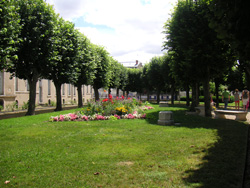You are here: Home > Heritage > Parks and gardens
Parks and gardens
An Art Deco garden: the Prés Fichaux
 What gives this garden its special charm is the sculpted vegetation : the hedges, the distinctively French lime trees, the immaculate lawns, the beautifully trimmed yews, which are enhanced by the less orderly arrangement of the flower-beds and ponds.
What gives this garden its special charm is the sculpted vegetation : the hedges, the distinctively French lime trees, the immaculate lawns, the beautifully trimmed yews, which are enhanced by the less orderly arrangement of the flower-beds and ponds.
The Prés Fichaux, inaugurated in 1930, still boasts typically Art Deco ornaments and statues which earned its addition to the supplementary inventory of historic monuments in 1990.
A brief history : Paul Marguerita (1886-1942), who left his mark on many a garden in Bourges, created the Prés Fichaux between 1923 and 1930 on the site of the marshland known in the Middle Ages as the " Prés Fiscaux " which belonged to the Abbey of Saint Ambroix and the inhabitants of its community.
The City Hall garden (or gardens of the Archibishop's palace)
 These gardens lie at the foot of the cathedral and are composed of 2 distinct parts :
These gardens lie at the foot of the cathedral and are composed of 2 distinct parts :
- the first, prolonging the former Archbishop's Palace, is a formal geometrical garden, with flowers, neatly trimmed trees, immaculate lawns ..
- the second, which is densely planted with trees radiating from the pond.
A brief history : the famous gardener Le Nôtre was consulted for this project in 1681 but the first drafts were, apparently, not his work.
Of particular note : the bandstand (1910) and the 4 monumental bronze vases representing the 4 seasons. These were created by Louis-Léon Cugnot at the end of the 19th century, added to the supplementary inventory of historic monuments in 1990 and delicately restored in 1994.
The Cardinal Joseph Lefebvre garden
 Inaugurated in May 1999, this garden is the first part of the development of the Saint-Etienne cathedral surroundings.
Inaugurated in May 1999, this garden is the first part of the development of the Saint-Etienne cathedral surroundings.
Nestling in a setting made of high trees, whose most remarkable are a fringed leaf beech and a Sequoiadendron giganteum, a small formal garden sparkles with colors. Surrounded by regular beds of roses, framed with box trees and curtain-trimmed hornbeams, a reflecting water basin surmounted by the Corbin's statue, which always kept a watchful eye on this place, brings its note of freshness.
The Jean de Berry garden
 This garden was laid out in the 1920s and is a rare example of the composite style, a harmonious combination of geometrical and landscape gardening.
This garden was laid out in the 1920s and is a rare example of the composite style, a harmonious combination of geometrical and landscape gardening.
Replanted in 1989, its 5700 square metres are a pleasant expanse of greenery in the grounds of a large school complex.
The Edouard André garden
 An ingenious idea was at the origin of this garden : it was created for the specific pleasure of people with impaired mobility.
An ingenious idea was at the origin of this garden : it was created for the specific pleasure of people with impaired mobility.
They can help care for the cold-frames and flower-beds, which are accessible for wheelchairs.
Visitors can admire a unique collection of rare peonies, trees and shrubs.
A brief history : Edouard andré, a gardener of international repute, was born in Bourges in 1840.
The Lazenay park
 The work of Gilles Clément, creator of the "Garden in Movement ", this is a park to explore.
The work of Gilles Clément, creator of the "Garden in Movement ", this is a park to explore.
"We pruned the elms, freed them of any ivy and removed large quantities of dogwood. .
But elsewhere, the ivy was left to creep and trail round the entrance to a cave.
Some paths running through thickets and clearings have been widened but elsewhere they have been left untouched, any natural obstacles remaining intact, with a new scene waiting to be discovered at each turning. "
The law courts garden
 Along the frontage of the former covent of the Ursulines, rows of lime frees and stone benches look after Diane and Psyché, two marble statues of the XIXth century.
Along the frontage of the former covent of the Ursulines, rows of lime frees and stone benches look after Diane and Psyché, two marble statues of the XIXth century.
The Gibjoncs landscaped garden
 This 8-hectare garden, designed by the City's Parks and Gardens Department, is composed of a succession of sections bordered by flower-beds, where over 10 000 perennials explode into a blaze of colour, a 15 metre fountain, a pyramid engraved witht the Declaration of the Rights of Man, not to mention a large square surrounded by tiers, a sand-pit and play areas for children.
This 8-hectare garden, designed by the City's Parks and Gardens Department, is composed of a succession of sections bordered by flower-beds, where over 10 000 perennials explode into a blaze of colour, a 15 metre fountain, a pyramid engraved witht the Declaration of the Rights of Man, not to mention a large square surrounded by tiers, a sand-pit and play areas for children.
